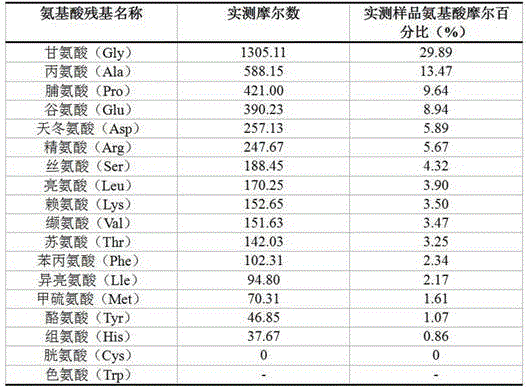Process for preparing fish skin antifreeze peptide through one-step enzymatic hydrolysis
An antifreeze peptide and enzymatic hydrolysis technology, which is applied in the field of one-step enzymatic hydrolysis to prepare fish skin antifreeze peptides, can solve the problems of frost cracking and water separation, and achieve the effect of less operation steps, low requirements for equipment and instruments, and low cost of consumables
- Summary
- Abstract
- Description
- Claims
- Application Information
AI Technical Summary
Problems solved by technology
Method used
Image
Examples
Embodiment 1
[0028] (1) Material selection: choose the skin of Spanish mackerel, which is more produced near the coast, as the raw material for antifreeze peptide extraction;
[0029] (2) Cleaning: Wash the inside and outside of the taken Spanish mackerel skin with water, control the water temperature at 4°C, and remove the excess debris adhered to the inside of the fish skin;
[0030] (3) Homogenization: Mix fish skin and water at a W / V ratio of 1:5, and place in a beater for homogenization;
[0031] (4) Enzymolysis: Alkaline protease was used to enzymolyze the fish skin homogenate, the ratio of enzyme to substrate was controlled to be 1:15, the pH of enzymolysis was 8, the temperature of enzymolysis was 40°C, and the time of enzymolysis was 90min. Cryopeptide crude solution;
[0032] (5) Membrane filtration: After centrifuging the crude solution of antifreeze peptide, take the supernatant, and select ultrafiltration membranes with molecular weight cut-offs of 20kDa, 10kDa and 5kDa under...
Embodiment 2
[0036] (1) Material selection: choose the skin of Spanish mackerel, which is more produced near the coast, as the raw material for antifreeze peptide extraction;
[0037] (2) Cleaning: Wash the inside and outside of the taken mackerel skin with water, control the water temperature at 7°C, and remove the excess debris adhering to the inside of the fish skin;
[0038] (3) Homogenization: Mix fish skin and water at a W / V ratio of 1:5, and place in a beater for homogenization;
[0039] (4) Enzymolysis: Alkaline protease was used to enzymolyze the fish skin homogenate, the ratio of enzyme to substrate was controlled at 1:20, the pH of enzymolysis was 8.5, the temperature of enzymolysis was 45°C, and the time of enzymolysis was 100min. Cryopeptide crude solution;
[0040] (5) Membrane filtration: After centrifuging the crude solution of antifreeze peptide, take the supernatant, and select ultrafiltration membranes with molecular weight cut-offs of 20kDa, 10kDa and 5kDa under the co...
Embodiment 3
[0044] (1) Material selection: choose the skin of Spanish mackerel, which is more produced near the coast, as the raw material for antifreeze peptide extraction;
[0045] (2) Cleaning: Wash the inside and outside of the taken mackerel skin with water, control the water temperature at 10°C, and remove the excess debris adhered to the inside of the fish skin;
[0046] (3) Homogenization: Mix fish skin and water at a W / V ratio of 1:5, and place in a beater for homogenization;
[0047] (4) Enzymolysis: Alkaline protease was used to enzymolyze the fish skin homogenate, the ratio of enzyme to substrate was controlled to be 1:30, the pH of enzymolysis was 9, the temperature of enzymolysis was 50°C, and the time of enzymolysis was 120min. Cryopeptide crude solution;
[0048] (5) Membrane filtration: After centrifuging the crude solution of antifreeze peptide, take the supernatant, and select ultrafiltration membranes with molecular weight cut-offs of 20kDa, 10kDa and 5kDa under the con...
PUM
 Login to View More
Login to View More Abstract
Description
Claims
Application Information
 Login to View More
Login to View More - R&D
- Intellectual Property
- Life Sciences
- Materials
- Tech Scout
- Unparalleled Data Quality
- Higher Quality Content
- 60% Fewer Hallucinations
Browse by: Latest US Patents, China's latest patents, Technical Efficacy Thesaurus, Application Domain, Technology Topic, Popular Technical Reports.
© 2025 PatSnap. All rights reserved.Legal|Privacy policy|Modern Slavery Act Transparency Statement|Sitemap|About US| Contact US: help@patsnap.com



